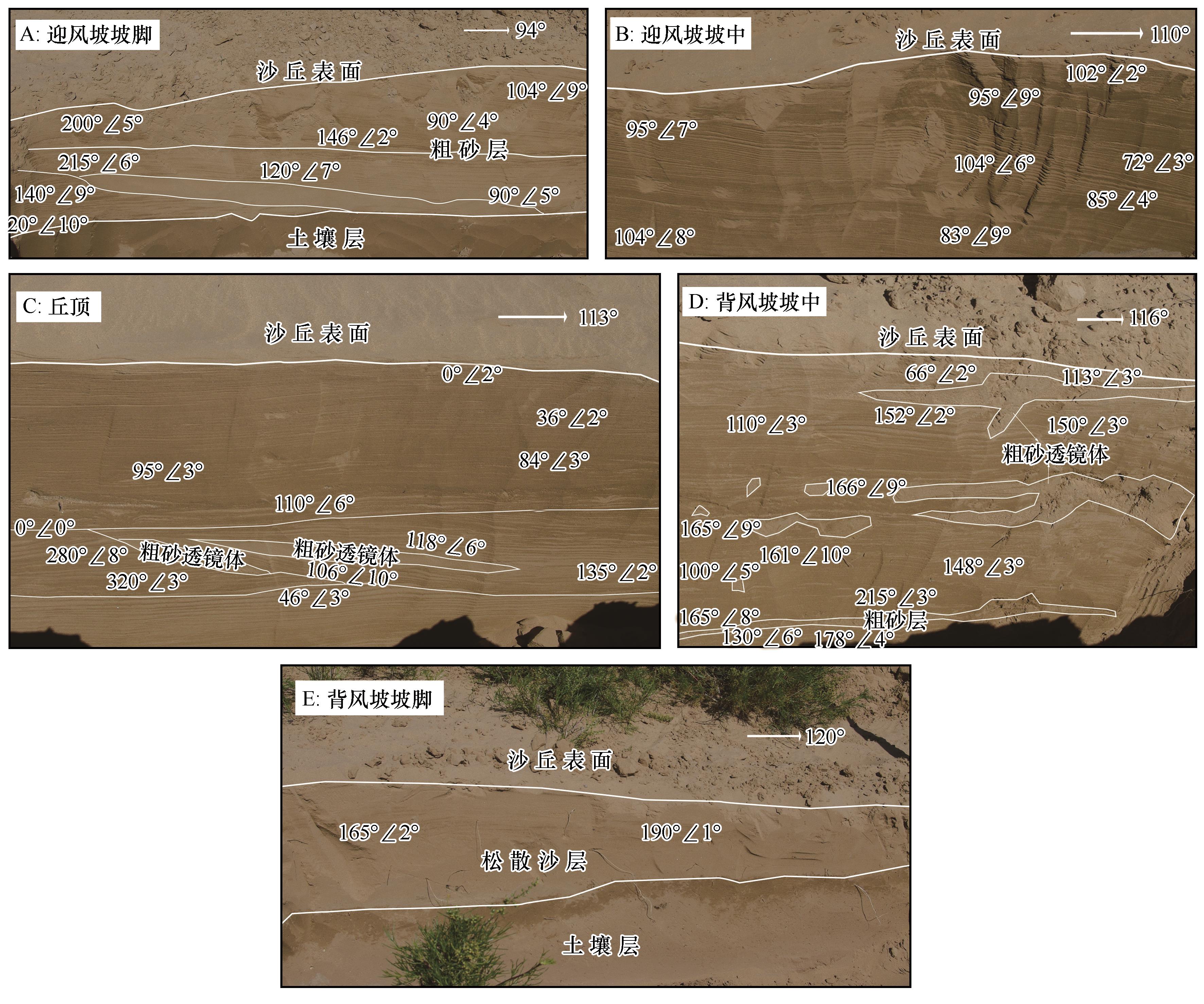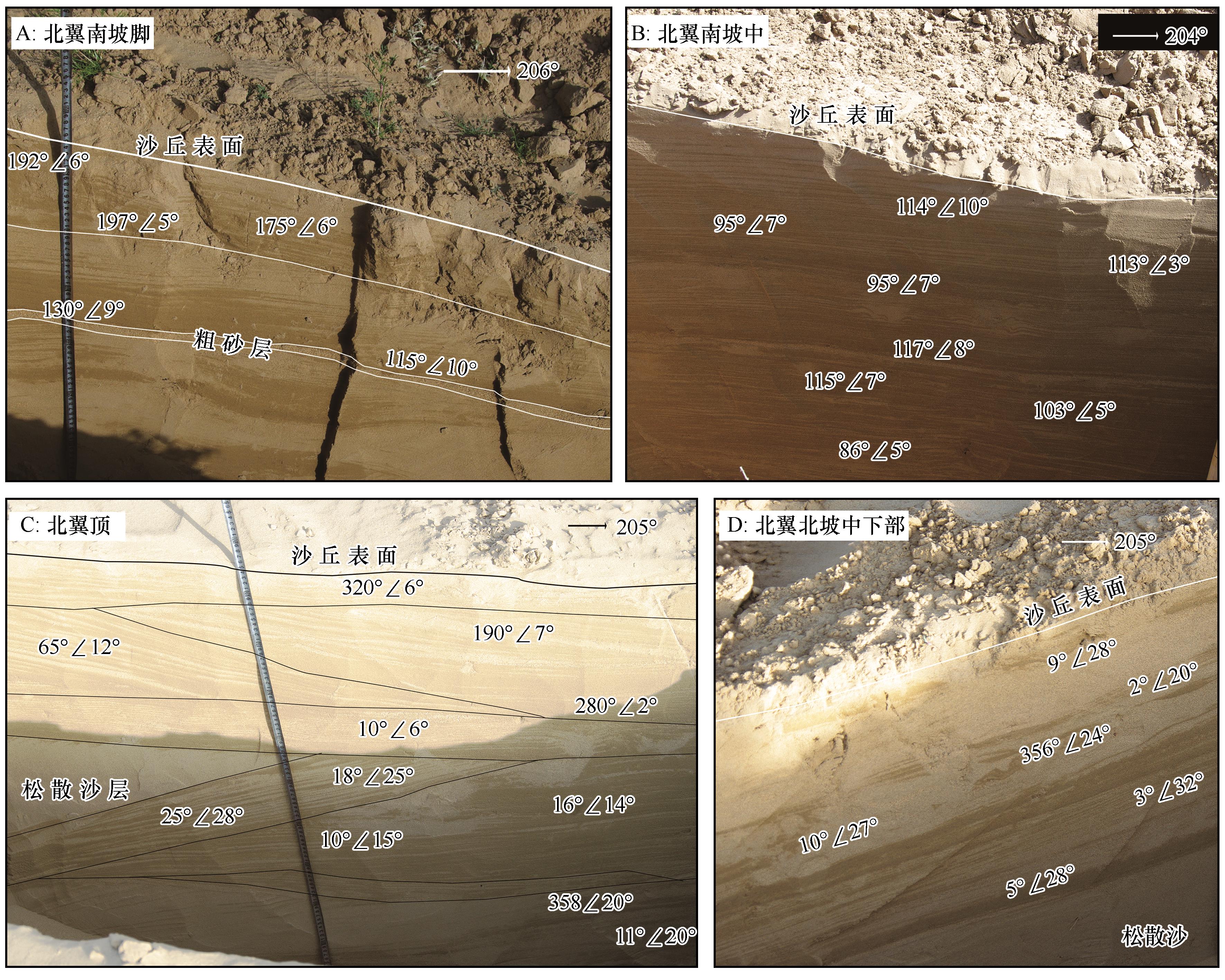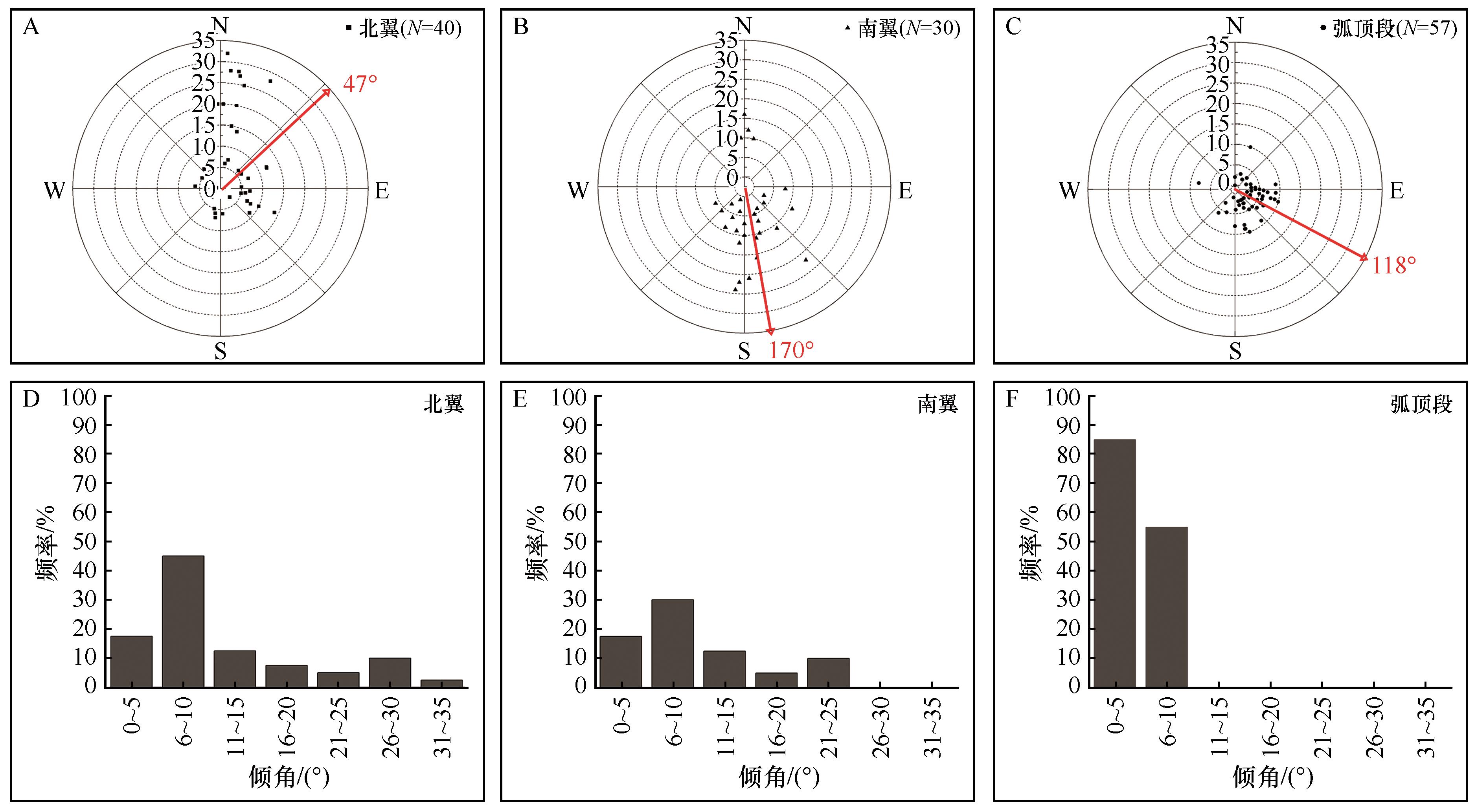
- CN 62-1070/P
- ISSN 1000-694X
- Bimonthly 1981

Journal of Desert Research ›› 2024, Vol. 44 ›› Issue (5): 41-49.DOI: 10.7522/j.issn.1000-694X.2024.00026
Previous Articles Next Articles
Yixin Ma( ), Zifeng Wu, Zhuoran Wang, Xujiao Han, Youhan Wu, Hasi Eerdun(
), Zifeng Wu, Zhuoran Wang, Xujiao Han, Youhan Wu, Hasi Eerdun( )
)
Received:2023-11-07
Revised:2024-02-04
Online:2024-09-20
Published:2024-10-15
Contact:
Hasi Eerdun
CLC Number:
Yixin Ma, Zifeng Wu, Zhuoran Wang, Xujiao Han, Youhan Wu, Hasi Eerdun. Internal sedimentary structure of source-limited parabolic dune in southern margin of Hobq Desert[J]. Journal of Desert Research, 2024, 44(5): 41-49.
Add to citation manager EndNote|Ris|BibTeX
URL: http://www.desert.ac.cn/EN/10.7522/j.issn.1000-694X.2024.00026
| 年份 | 沙丘轴长/m | 翼间宽度/m | 弧顶段长/m | 南翼宽度/m | 北翼宽度/m | 弧顶段移动距离/m | 南翼移动距离/m | 北翼移动距离/m |
|---|---|---|---|---|---|---|---|---|
| 2005 | 358.71 | 116.48 | 85.98 | 21.12 | 29.38 | — | — | — |
| 2010 | 419.93 | 123.37 | 85.02 | 22.56 | 28.46 | 57.52 | 6.78 | 2.32 |
| 2012 | 428.09 | 125.43 | 89.09 | 16.21 | 32.14 | 8.75 | 3.67 | 0.93 |
Table 1 Dune morphology parameters in different years
| 年份 | 沙丘轴长/m | 翼间宽度/m | 弧顶段长/m | 南翼宽度/m | 北翼宽度/m | 弧顶段移动距离/m | 南翼移动距离/m | 北翼移动距离/m |
|---|---|---|---|---|---|---|---|---|
| 2005 | 358.71 | 116.48 | 85.98 | 21.12 | 29.38 | — | — | — |
| 2010 | 419.93 | 123.37 | 85.02 | 22.56 | 28.46 | 57.52 | 6.78 | 2.32 |
| 2012 | 428.09 | 125.43 | 89.09 | 16.21 | 32.14 | 8.75 | 3.67 | 0.93 |

Fig.4 Schematic diagram of bedding at the nose of parabolic dune. A. The foot of the windward slope; B. The middle of the windward slope; C. Dune crest; D. The middle of the lee slope; E. The foot of the leeward slpoe

Fig.5 Schematic diagram of bedding at the north arm of parabolic dune. A. The foot of inner slope the north arm; B. The middle of the inner slope of the north arm; C. The crest of the north arm; D. The lower part of the outer slope of the north arm

Fig.6 Schematic diagram of bedding at the south arm of parabolic dune. A. The outer slope of the south arm; B. The crest of the south arm; C. The inner slope of the south arm

Fig.7 Rose diagram of cross-bedding orientations and frequency diagram of dip angles in different units of sand dunes. (A) Rose diagram of orientations on the north arm; (B) Rose diagram of orientations on the south arm; (C) Rose diagram of orientations on the nose of the dune; (D) Frequency diagram of dip angle on the north arm; (E) Frequency diagram of dip angle on the south arm; (F) Frequency diagram of dip angle on the nose of the dune
| 1 | Pye K, Tsoar H.Aeolian Sand & Sand Dunes[M].Berlin,Germany:Springer,2009:329-367. |
| 2 | McKee E D.Structures of dunes at White Sands National Monument,New Mexico[J].Sedimentology,1966,7(1):3-69. |
| 3 | McKee E D.A Study of Global Sand Seas[R].Honululu,Hawaii,USA:University Press of the Pacific,1979:73-125. |
| 4 | Hunter R E.Basic types of stratification in small aeolian sand dunes[J].Sedimentology,1977,4(2):361-388. |
| 5 | Tsoar H.Internal structure and surface geometry of longitudinal(seif) dunes[J].Journal of Sedimentary Research,1982,52(3):823-831. |
| 6 | Nielson J, Kocurek G.Surface processes,deposits,and development of star dunes:Dumont dune field,California[J].Geological Society of America Bulletin,1987,99(2):177-186. |
| 7 | 哈斯.腾格里沙漠东南缘格状沙丘沉积构造的解析[J].地学前缘,2004,11(1):277-278. |
| 8 | Mckee E D, Bigarella J J.Deformational structures in Brazilian coastal dunes[J].Journal of Sedimentary Research,1972,42(3):670-681. |
| 9 | Bristow C S.An introduction to ground penetrating radar(GPR)in sediments[J].Geological Society,London,Special Publications,2003,211(1):1-7. |
| 10 | 刘瑞,李志忠,靳建辉,等.古尔班通古特沙漠西南缘新月形沙丘内部沉积构造特征研究[J].干旱区地理,2022,45(3):802-813. |
| 11 | 张潇,严平,董苗,等.柴达木盆地托拉海河下游复合新月形沙丘沉积构造探地雷达探测初步结果[J].中国沙漠,2023,43(1):160-168. |
| 12 | 陈义群,肖柏勋.论探地雷达现状与发展[J].工程地球物理学报,2005,2(2):149-155. |
| 13 | 傅天阳,李孝泽.探地雷达在沙漠研究中的应用综述[J].中国沙漠,2014,34(1)49-55. |
| 14 | 吴正,等.风沙地貌与治沙工程学[M].北京:科学出版社,2003:139-155. |
| 15 | 朱震达,吴正,刘恕,等.中国沙漠概论[M].北京:科学出版社,1980:8-29. |
| 16 | 闫娜,哈斯,刘怀泉,等.抛物线形沙丘的形态与演变的研究进展[J].中国沙漠,2010,30(4):801-807. |
| 17 | Bailey S D, Bristow C S.Migration of parabolic dunes at Aber-fraw,Anglesey,north Wales[J].Geomorphology,2004,59(1/4):165-174. |
| 18 | 杜会石,哈斯额尔敦,雷军,等.基于3S技术的库布齐沙漠抛物线形沙丘形态变化研究[J].水土保持通报,2013,33(3):165-169. |
| 19 | Wolfe S A, David P P.Parabolic dunes:examples from the Great Sand Hills,southwestern Saskatchewan:Canadian landform examples 34[J].Canadian Geographer,1997,41(2):207-214. |
| 20 | 马倩,武胜利,曾雅娟,等.艾比湖流域抛物线形沙丘形态特征[J].中国沙漠,2014,34(4):955-960. |
| 21 | 魏振海,董治宝,胡光印,等.若尔盖盆地沙丘形成分布影响因素探讨[J].中国沙漠,2009,29(6):1035-1042. |
| 22 | 张萍,哈斯,杜会石,等.抛物线形沙丘与油蒿灌丛之间的动态关系[J].科学通报,2011,56(35):3003-3010. |
| 23 | Stetler L D, Gaylord D R.Evaluating eolian-climatic influences using a regional climate model from Hanford,Washington(USA)[J].Geomorphology,1996,17(1/3):99-113. |
| 24 | Tsoar H, Blumberg D G.Formation of parabolic dunes from barchan and transverse dunes along Israel's Mediterranean Coast[J].Earth Surface Process and Landforms,2002,27(11):1147-1161. |
| 25 | 周炎广,王卓然,青达木尼,等.浑善达克沙地固定沙丘风蚀坑形态变化及其动力学机制[J].科学通报,2023,68(11):1298-1311. |
| 26 | 潘凯佳,张正偲,梁爱民.反向沙丘近地层气流变化及其对沙丘形态的影响[J].中国沙漠,2021,41(2):1-8. |
| 27 | 杨迎,吕萍,马芳,等.乌兰布和沙漠西南部风况对穹状沙丘形成的影响[J].中国沙漠,2021,41(2):19-26. |
| 28 | 何强强,毛东雷,朱文煜,等.新疆策勒绿洲-沙漠过渡带不同植被下的沙丘形态特征及沉积物粒度分析[J].水土保持学报,2022,36(6):70-81. |
| 29 | 董苗,严平,王晓旭,等.雅鲁藏布江山南宽谷段爬坡沙丘表层沉积物特征[J].中国沙漠,2022,42(2):153-163. |
| 30 | Li S, Liu X W, Li H C,et al.A wind tunnel simulation of the dynamic processes involved in sand dune formation on the western coast of Hainan lsland[J].Journal of Geographical Sciences,2007,17(4):453-459. |
| 31 | 任文军,张庆龙,张进,等.鄂尔多斯盆地中央古隆起板块构造成因初步研究[J].大地构造与成矿学,1999,23(2):191-196. |
| 32 | 刘丹,管超,周炎广,等.库布齐沙漠南缘沙丘固定与活化过程中的形态演变[J].中国沙漠,2016,36(5):1223-1229. |
| 33 | 殷婕,安晶,哈斯额尔敦,等.库布齐沙漠南缘风沙-植被相互作用及其景观效应[J].生态学报,2022,42(21):8869-8880. |
| 34 | 吴泽群.内蒙古河套地区晚第四纪库布齐沙漠的形成和演化[D].北京:中国地质大学(北京),2017. |
| 35 | 陶彬彬,哈斯额尔敦,乌格特茉勒,等.库布齐沙漠南缘抛物线形沙丘表面风速与输沙率的变异[J].中国沙漠,2015,35(6):1445-1452. |
| 36 | Hugenholtz C H, Wolfe S A, Moorman B J.Effects of sand supply on the morphodynamics and stratigraphy of active parabolic dunes,Bigstick Sand Hills,southwestern Saskatchewan[J].Canadian Journal of Earth Sciences,2008,45(3):321-335. |
| 37 | 哈斯,董光荣,王贵勇.腾格里沙漠东南缘格状沙丘的形态-动力学研究[J].中国科学,1999,29(5):466-471. |
| 38 | Pye K, Tsoar H.Aeolian Sand and Sand Dune[M].London,UK:Unwin Hyman,1990:221-253. |
| 39 | Bigarella J J.Lagoa dunefield,State of Santa Catarina,Brazil:a model of eolian and pluvial activity[J].Boletim Paranaense de Geociencias,1975,33:133-167. |
| 40 | Pye K.Geomorphic evolution of coastal sand dunes in a humid tropical environment:North Queensland[D].Cambridge,UK:University of Cambridge,1980. |
| 41 | 邓涛,李志忠,靳建辉,等.探地雷达在福建漳浦海岸抛物线沙丘沉积构造探测中的应用[J].中国沙漠,2015,35(4):882-889. |
| 42 | McKee E D, Tibbitts G C.Primary structures of a seif dune and associated deposits in Libya.[J].Journal of Sedimentary Research,1964,34(1):5-17. |
| 43 | Rubin D M, Hunter R E.Why deposits of longitudinal dunes are rarely recognized in the geologic record[J].Sedimentology,1985,32(1):147-157. |
| 44 | 吴正.风沙地貌学[M].北京:科学出版社,1987:87-128. |
| 45 | Bigarilla J J, Salamuri R.Early Meozoni wind patterns as suggested by dune bedding in the Botucatu sandstone of Brazil and Uruguay[J].Geological Society of America Bulletin,1961,72(7):1089-1105. |
| 46 | 哈斯,王贵勇,董光荣.沙丘背风侧气流及其沉积类型与意义[J].沉积学报,2001(1):96-100. |
| 47 | Parrish J T, Peterson F.Wind direction predicted from global circulation models and wind direction determined from eolian sandstones of the western United States-a comparison[J].Sedimentary Geology,1988,56(1/4):261-282. |
| 48 | Glennie K W.Early Permian(Rotliegendes) palaeowind of the North Sea[J].Sedimentary Geology,1983,34(2/3):245-265. |
| 49 | Smyth T A, Delgado-Fernandez I, Jackson D W,et al.Greedy parabolics:wind flow direction within the deflation basin of parabolic dunes is governed by deflation basin width and depth[J].Progress in Physical Geography:Earth and Environment,2020,44(5):643-660. |
| [1] | Lijiang Shi, Qianjin Li, Shan Gao, Yongning Li, Xiaojun Yao, Xiaolong Zhang, Yinbo Zhang, Feng Gao. Analysis on the spatiotemporal evolution and influencing factors of green technology innovation capability of urban agglomerations in the middle reaches of the Yellow River [J]. Journal of Desert Research, 2024, 44(6): 122-134. |
| [2] | Xiya Liu, Haibing Wang, Hejun Zuo, Jianying Guo. Grain size of the Hobq Desert sediment and its indicating significance for the sedimentary environment [J]. Journal of Desert Research, 2024, 44(6): 240-248. |
| [3] | Xiaoya Yi, Dequan Zhang, Yong Liu, Xurigan, Shengbo Xie. Vegetation change and its response to climate factors in Hanggin Banner,Inner Mongolia, China from 2000 to 2020 [J]. Journal of Desert Research, 2024, 44(3): 51-62. |
| [4] | Min Han, Yong Gao, Minghui He, Ru Yan, Fang Bai, Wenyuan Yang, Xiaole Li, Xiaoman Yuan, Juan Yang. Morphology and sediment characterization of a scrub sandpile in Caragana tibetica [J]. Journal of Desert Research, 2024, 44(2): 185-195. |
| [5] | Chao Guan, Zifeng Wu, Hasi Eerdun. Dynamic characteristics and genesis of reticulate dunes on the western fringe of the Hobq Desert [J]. Journal of Desert Research, 2024, 44(2): 239-253. |
| [6] | Kongsen Wu, Dongyan Kong, Chuanyan An. Spatial-temporal evolution pattern and coordinated development of human-environment system resilience in the Yellow River Basin [J]. Journal of Desert Research, 2023, 43(6): 246-257. |
| [7] | Wenfeng Chi, Yuetian Wang, Xiaohong Dang, Xiaoguang Wu, Qiancheng Luo. Temporal variation and spatial pattern of soil erosion in the Yellow River Basin [J]. Journal of Desert Research, 2023, 43(3): 305-317. |
| [8] | Mengjun Hu, Jing Zhuang, Wenli Sun, Dengyou Zheng, Tianqi Ji, Aokang Xu. Geochemical characteristics of major elements and environmental evolution in the Holocene in the northeastern Tibetan Plateau [J]. Journal of Desert Research, 2023, 43(2): 11-20. |
| [9] | Funing Yang, Lü Ping, Fang Ma, Min Cao, Nan Xiao, Lixia Gu, Ying Yang. Morphological evolution and migration characteristics of reticulate dunes at southern fringe of Tengger Desert [J]. Journal of Desert Research, 2023, 43(1): 107-115. |
| [10] | Xiao Zhang, Ping Yan, Miao Dong, Xiaokang Liu, Wenjie Yuan, Xiaoxu Wang. Preliminary results of sedimentary structure of compound crescentic dune in the lower reaches of Tora River Basin, Qaidam Basin probed with ground penetrating radar [J]. Journal of Desert Research, 2023, 43(1): 160-168. |
| [11] | Guojun Sun, Linxuan Fang, Haijun Liu. The characteristics and influencing factors of the development of cultural industry in Gansu Province [J]. Journal of Desert Research, 2023, 43(1): 75-82. |
| [12] | Jinlian Hao, Li Wang, Gennian Sun, Fankai Sun, Donghua Wang. Spatial pattern evolution of high-quality development in the Yellow River Basin on the perspective of new development philosophy [J]. Journal of Desert Research, 2022, 42(6): 266-276. |
| [13] | Wanyun Luo, Fubo Wang, Hui Sun. Spatial pattern evolution characteristics of high-quality green development level in the Yellow River Basin [J]. Journal of Desert Research, 2022, 42(3): 11-20. |
| [14] | Shuo Qiao, Haibing Wang, Hejun Zuo, Xiya Liu, Yueru Wu. Evolution of ecological service value and network pattern of Mu Us Sandy Land [J]. Journal of Desert Research, 2022, 42(3): 118-126. |
| [15] | Lei Xie, Renwei He, Wentao Shi, Hongzheng Pu. Spatio-temporal evolution and dynamic mechanism of urban-rural integration development in the Yellow River Basin [J]. Journal of Desert Research, 2022, 42(3): 31-40. |
| Viewed | ||||||
|
Full text |
|
|||||
|
Abstract |
|
|||||
©2018Journal of Desert Research
Tel:0931-8267545
Email:caiedit@lzb.ac.cn;desert@lzb.ac.cn
Support:Magtech